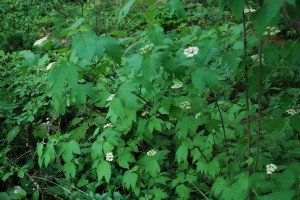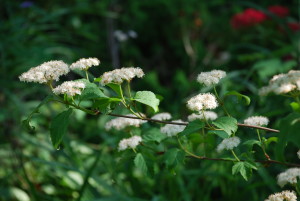The genus Viburnum is a rich source of over 150 species of great flowering shrubs worldwide. Many viburnums are native to North America including mapleleaf viburnum (Viburnum acerifolium). This totally underutilized deciduous viburnum is a great choice to plant in shrub borders, foundation, or hedging, as well as to naturalize in an open woodland area (zone 3-8).
Shrub grows 4 – 6 feet tall and 3 – 4 feet wide. In late winter before spring bud break, swelling flower buds turn distinctively pale purple. Creamy white 1 to 3 inch wide flowers (cymes) appear in early to mid-May. Flowers give way to pea-sized fruits that ripen to bluish-black in late summer, and persist through most of winter. Shrub may form basal suckers and form colonies over many years.
Mapleleaf viburnum is a relatively small, rounded, suckering, deciduous, woodland shrub. Leaves are generally 3-lobed, 2-5 inches long, and very maple-like; juvenile foliage on seedling plants may not always develop side lobes. Leaves are opposite, ovate to rounded, coarsely toothed. Fall color is variable from one year to the next. When best, it is hard to beat, leaves turning purple to magenta in the fall.
Mapleleaf viburnum is easy to grow in average, medium moist, well-drained soil and in full sun to part shade. This viburnum is an exceptional grower in dry, shady woodland locales. Prune as needed immediately after spring flowering. Lightly feed with a granular fertilizer such as 10-10-10 or equivalent. It appears to be pH insensitive. Mulch to maintain a weed-free planting. Mapleleaf viburnum has no serious insect or disease problems and damage from deer feeding is minimal.
Mapleleaf viburnum is sold primarily by nurseries that specialize in selling native plants on-line.



 Posted in
Posted in 
